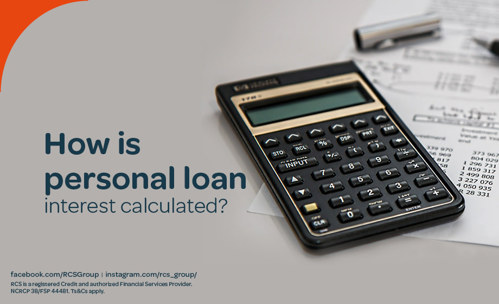How are personal loan interests calculated?
11 AUGUST 2023
Interest can be hard to understand, but it is important to know when applying for a personal loan. Read further to help yourself make smarter borrowing decisions. Learning how to calculate interest on personal loans is a crucial skill to have when you find yourself in the need to borrow money. Knowing the potential amount of interest that you will pay can help you decide if you can afford the loan repayments plus interest as well as negotiate your loan contract with your lender.
What is a personal loan?
Personal loans are a type of credit issued by lenders and financial institutions to borrowers that are in need of extra financial support for various reasons. These include one-off expenses, paying for an education, or a vacation. There are two types of loans; secured and unsecured. Secured loans are loans that are taken out against an asset or collateral, for example, your home. These types of loans typically have low-interest rates, as there is minimal risk.
Most personal loans are unsecured loans. This means that the loan is not backed against an asset that a lender can acquire if you default on the loan. Unsecured loans are based on your creditworthiness and thus come with a higher interest rate to match the extra risk the lender can take on.
Long-term vs. Short-term loans
The term of a loan refers to the period in which the loan must be paid back. Short term loans generally are between a few months to a year. Long-term loan repayments can last from 10 to 15 years. The length of your repayment term has an impact on how your interest is calculated. Shorter-term loans tend to have higher and less flexible interest rates, to reflect the short repayment period and the risks that come with it. Be sure to know the term of your repayment period when calculating interest.
What is interest?
When taking out a loan you have to pay back the original amount you borrowed - or the principal amount - along with interest. This is the fee that you pay for using the lender’s money and how they make a profit off from issuing loans. The interest rate is the percentage value that is most important when comparing financial products. It is the basic interest rate that does not take other fees or compounding into consideration. This means that the actual amount of interest you will pay might be higher than the stated annual interest rate.
Simple & Compounding interest
Simple interest is calculated on only the principal or original loan amount that you borrow. While compounding interest is calculated on the principal amount as well as on the accumulated interest over previous periods.
The effective rate of interest
This is the value that takes into account compounding interest over your loan. This can give you a better view of what interest you could be paying per month.
Annual percentage rate (APR)
Also called the comparison rate, APR shows the whole and true cost of your loan. It includes the interest rate along with any other fees or charges that apply. This value is crucial to know when deciding if you can afford the overall cost of a loan.
How is interest calculated on your personal loan?
During loan applications, before interest is calculated and your loan contract is drawn up, your credit score is the prime factor that influences the type of loan and the amount of risk the lender is willing to take. Keep a good credit score by repaying on time and managing your finances.
After this process, sit with your contract before you agree to anything and understand the factors that influence how much interest you will pay over the loan term. These are;
1. Your principal loan amount
Take into account if you are able to pay it back along with the lifestyle changes that you might experience.
2. The loan term
Short-term loans generally mean higher repayments with less interest. While long loan terms have lower monthly repayments but can cost more in interest.
3. Repayment schedule (weekly, fortnightly, or monthly)
More repayments mean less interest, due to compounding. However weekly repayments are not possible for everyone. Make sure your budget can cater to the number of repayments you need to make.
4. Repayment amount
The repayment amount does not only pay off your principal amount, but it also pays off the interest you owe over your loan period.
5. Interest rate
To calculate interest on your loan, be sure to use the stated annual interest rate.
How to calculate interest on a loan using simple interest
Here the interest rate is applied to your principal amount only.
Simple interest = P x i x n
P = Principle
i = interest rate
n = term of the loan
For example, 15% interest on an R10,000 loan that is taken out for three years equals the total amount of interest payable as R10,000 x 0.15 x 3 = R4,500.
How to calculate interest on a loan using compound interest
Compound interest = P[(n1+i)nt−1]
where:
P = Principle
i = interest rate in percentage terms
n = number of compounding periods per year
t = total number of years for the investment or loan
There are many online interest calculators to help you calculate how much interest you will pay over your loan term. Utilize them so you can plan and budget ahead.
Your personal loan application and subsequent contract results in extra financial responsibilities to keep track of and manage. Your monthly repayments will need to be budgeted beforehand along with any possible late-payment fees so you can pay back loans faster and smarter. Avoid this by creating a repayment schedule to stick to avoid missing late fees. However, there can be unpredictable circumstances that can impact your ability to repay. Invest in Customer Protection Insurance to safeguard your finances against these risks.
Educate yourself on the details of your personal loan and how much you will owe so that you can make wise borrowing decisions.
MORE ARTICLES ABOUT
RELATED ARTICLES

Education
28 AUGUST 2025
SA Research: How Parents Impact a Child’s Financial Intelligence

Education
12 JUNE 2025
Cultivating Tomorrow's Leaders: Equipping Young South Africans for Life’s Challenges

Education
28 MARCH 2025
